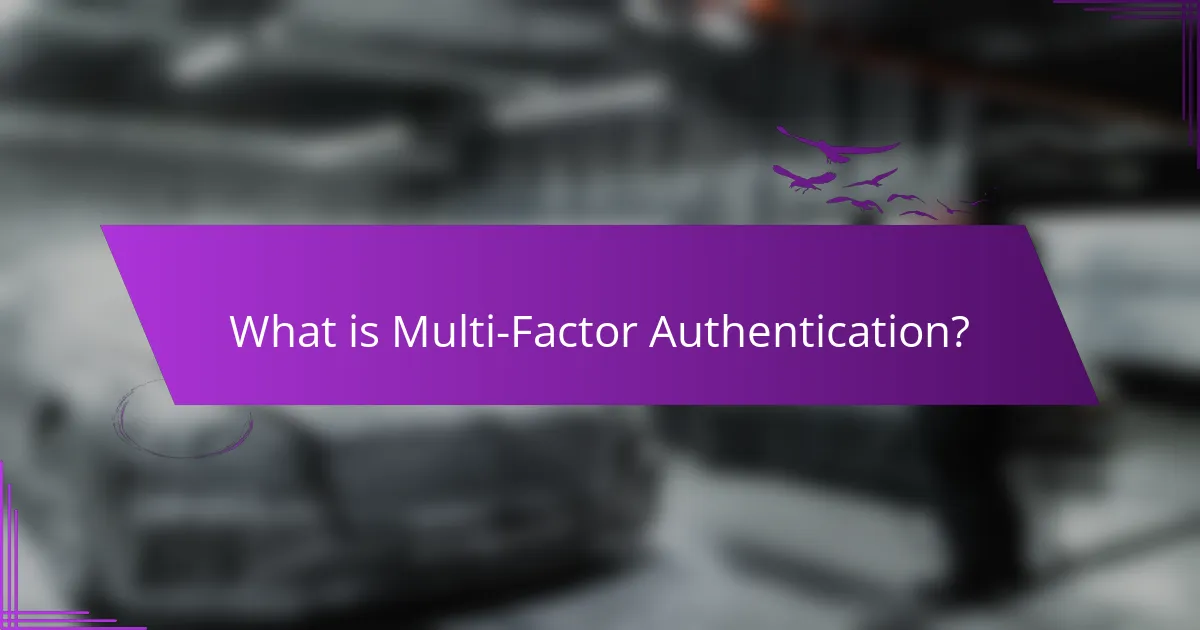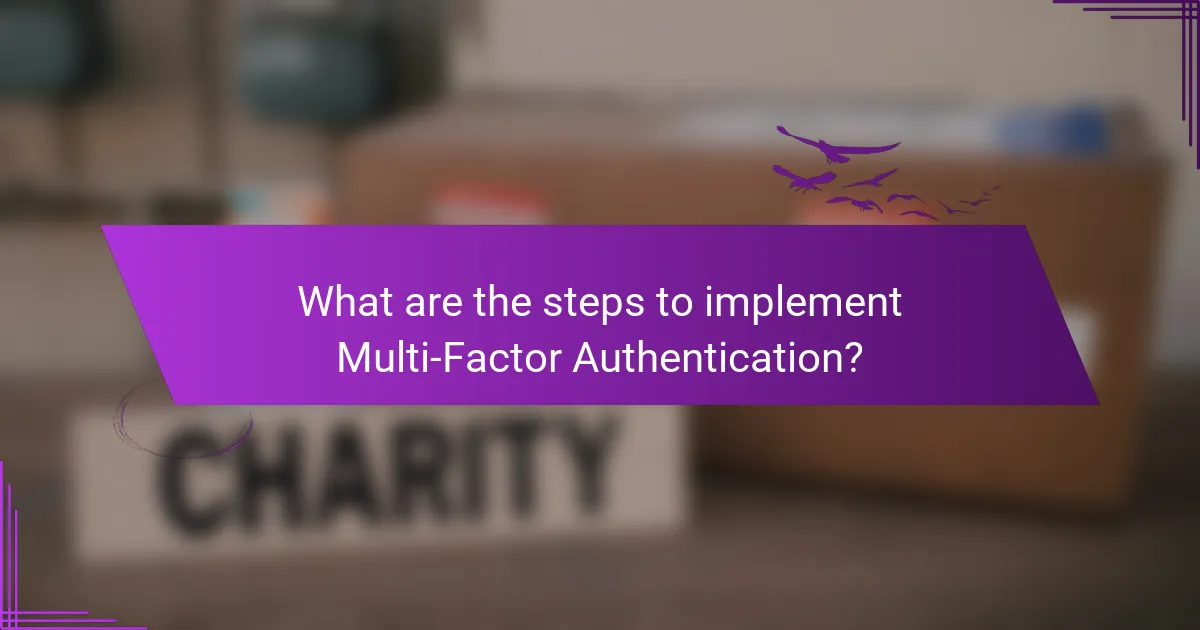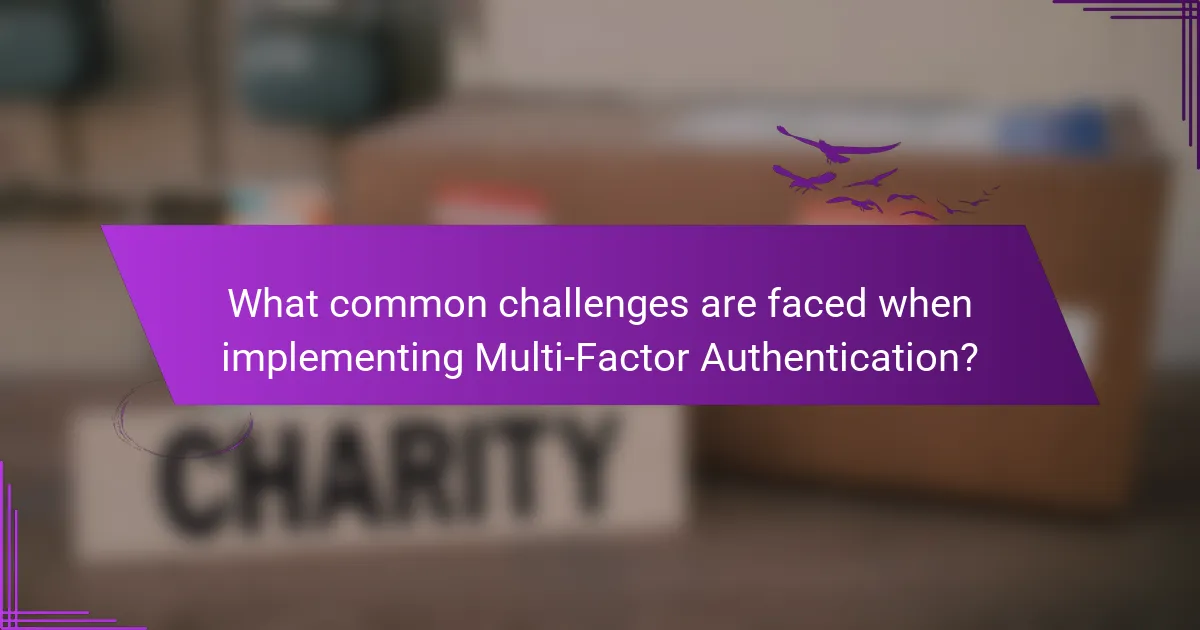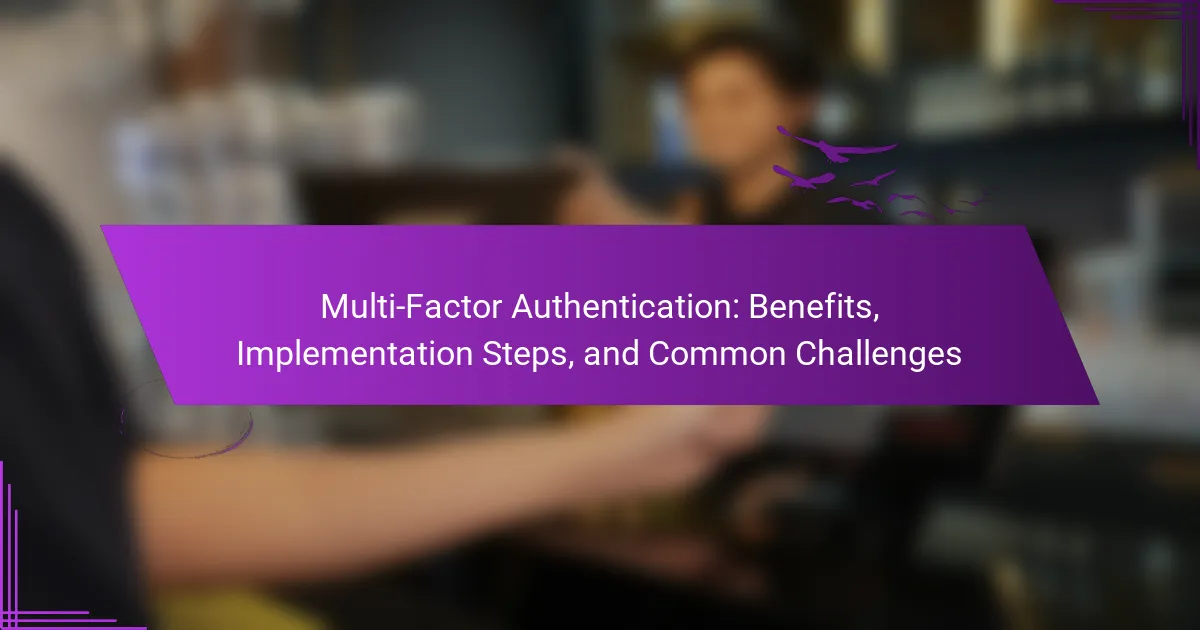
What is Multi-Factor Authentication?
Multi-Factor Authentication (MFA) is a security measure that requires multiple forms of verification to access an account. It combines two or more independent credentials: something you know (like a password), something you have (like a smartphone), and something you are (like a fingerprint). MFA significantly enhances security by adding layers of protection. According to the Cybersecurity & Infrastructure Security Agency, MFA can prevent unauthorized access even if a password is compromised. Implementing MFA reduces the risk of data breaches and identity theft. This method is widely adopted across various platforms and services for enhanced security.
How does Multi-Factor Authentication enhance security?
Multi-Factor Authentication (MFA) enhances security by requiring multiple forms of verification before granting access. This process typically involves something the user knows, such as a password, and something the user has, like a mobile device. By combining these factors, MFA significantly reduces the likelihood of unauthorized access. According to a study by Microsoft, MFA can block 99.9% of account compromise attacks. This statistic highlights the effectiveness of MFA in protecting sensitive information. The additional verification step makes it more challenging for cybercriminals to gain access, even if they have obtained a password. Overall, MFA provides a robust layer of security that traditional password-only systems lack.
What are the different authentication factors used in Multi-Factor Authentication?
The different authentication factors used in Multi-Factor Authentication (MFA) include something you know, something you have, and something you are. “Something you know” typically refers to passwords or PINs. This factor relies on the user’s knowledge to gain access. “Something you have” includes physical items like security tokens, smart cards, or mobile devices. This factor requires the user to possess a specific item for authentication. “Something you are” involves biometric data, such as fingerprints or [censured] recognition. This factor uses unique physical traits for verification. Each factor enhances security by requiring multiple forms of verification to access systems or data.
How does the combination of factors improve security compared to single-factor authentication?
The combination of factors in multi-factor authentication (MFA) significantly enhances security compared to single-factor authentication (SFA). MFA requires users to provide multiple forms of verification. This can include something they know, such as a password, something they have, like a smartphone, or something they are, such as a fingerprint.
By requiring multiple factors, MFA reduces the likelihood of unauthorized access. Even if one factor is compromised, the additional factors provide an extra layer of protection. Research indicates that using MFA can block up to 99.9% of automated attacks. This statistic highlights the effectiveness of combining different authentication methods.
In contrast, SFA relies on a single credential, making it more vulnerable to attacks such as phishing or credential theft. Therefore, the combination of factors in MFA creates a more robust security posture.
What are the key benefits of implementing Multi-Factor Authentication?
Implementing Multi-Factor Authentication (MFA) significantly enhances security. MFA requires users to provide multiple forms of verification, making unauthorized access more difficult. This method reduces the risk of data breaches, as it adds layers of security beyond just passwords. According to a study by Microsoft, MFA can block over 99.9% of automated attacks. Additionally, MFA can increase user trust and confidence in the security of their accounts. It also helps organizations comply with regulatory requirements, such as GDPR or HIPAA, which mandate stronger security measures. By implementing MFA, businesses can protect sensitive information and reduce potential financial losses from cyber incidents.
How does Multi-Factor Authentication reduce the risk of unauthorized access?
Multi-Factor Authentication (MFA) reduces the risk of unauthorized access by requiring multiple forms of verification. It typically combines something the user knows, like a password, with something the user has, such as a smartphone or hardware token. This layered approach makes it significantly harder for attackers to gain access.
For instance, even if a password is compromised, the attacker would still need the second factor to access the account. According to a report by the Cybersecurity & Infrastructure Security Agency, MFA can block over 99% of automated attacks. This statistic illustrates the effectiveness of MFA in enhancing security and protecting sensitive information.
What impact does Multi-Factor Authentication have on user trust and confidence?
Multi-Factor Authentication (MFA) significantly enhances user trust and confidence. MFA adds an extra layer of security beyond just a password. This additional verification helps protect user accounts from unauthorized access. Research indicates that 90% of data breaches can be prevented with MFA. Users feel more secure knowing their accounts are better protected. Enhanced security measures lead to increased user satisfaction and loyalty. As a result, organizations implementing MFA often see improved customer relationships. Trust in digital services grows when users believe their data is safe.

What are the steps to implement Multi-Factor Authentication?
Identify the systems that require Multi-Factor Authentication (MFA). Assess the current security measures in place. Choose an MFA method, such as SMS, email, or authenticator apps. Configure the chosen MFA method within the system settings. Communicate the changes to users and provide guidance on setup. Implement the MFA solution and conduct testing to ensure functionality. Monitor the system for any issues post-implementation. Review and update the MFA process regularly to address new security threats.
How can organizations assess their need for Multi-Factor Authentication?
Organizations can assess their need for Multi-Factor Authentication (MFA) by evaluating their current security risks and compliance requirements. A risk assessment should identify sensitive data and systems that require protection. Organizations should consider the likelihood of data breaches and the potential impact on their operations. Compliance with regulations such as GDPR or HIPAA may necessitate MFA to protect personal information. Additionally, organizations should review their existing authentication methods for vulnerabilities. An analysis of past security incidents can provide insights into the effectiveness of current measures. Finally, consulting with cybersecurity experts can help tailor MFA solutions to specific organizational needs.
What factors should be considered during the assessment phase?
During the assessment phase of multi-factor authentication (MFA), several key factors should be considered. First, the specific security requirements of the organization must be evaluated. This includes understanding the sensitivity of the data being protected. Next, the existing infrastructure should be assessed to determine compatibility with MFA solutions. User experience is another critical factor; the solution should not hinder productivity. Additionally, the cost of implementation and ongoing maintenance must be analyzed. Regulatory compliance requirements also play a vital role in the assessment. Finally, potential user resistance should be anticipated and addressed. Each of these factors contributes to a comprehensive evaluation of MFA suitability for the organization.
How do organizations identify the right Multi-Factor Authentication solution?
Organizations identify the right Multi-Factor Authentication (MFA) solution by assessing their specific security needs. They evaluate the types of sensitive data that require protection. Organizations also consider the user experience to ensure ease of use. Cost-effectiveness is another critical factor in the selection process. They analyze the compatibility of the MFA solution with existing systems. Assessing the scalability of the solution is essential for future growth. Organizations should also investigate the vendor’s reputation and support services. Finally, regulatory compliance requirements may influence the choice of MFA solution.
What are the stages involved in the implementation process?
The stages involved in the implementation process of multi-factor authentication include planning, configuration, testing, deployment, and monitoring. During the planning stage, organizations assess their security needs and define goals. The configuration stage involves setting up the authentication system according to the specified requirements. Next, in the testing stage, the system is evaluated for functionality and security vulnerabilities. The deployment stage follows, where the system is rolled out to users. Finally, the monitoring stage ensures ongoing effectiveness and addresses any emerging issues. These stages are critical for ensuring a successful implementation of multi-factor authentication.
What best practices should be followed during the deployment of Multi-Factor Authentication?
Implementing Multi-Factor Authentication (MFA) requires adherence to several best practices. First, select a strong authentication method, such as biometrics or hardware tokens. These methods provide a higher level of security than SMS or email codes. Second, ensure that all users are educated about MFA and its importance. Training can reduce resistance and improve compliance. Third, implement MFA for all user accounts, especially for those with access to sensitive data. This approach minimizes vulnerabilities. Fourth, regularly review and update authentication methods. Security threats evolve, necessitating updates to stay ahead. Fifth, provide backup options for users who may lose access to their primary authentication method. This reduces frustration and potential lockouts. Finally, monitor and analyze authentication logs for unusual activity. This practice helps identify potential security breaches early. Following these best practices strengthens the security of MFA deployment and protects sensitive information.
How can organizations ensure user adoption and compliance with Multi-Factor Authentication?
Organizations can ensure user adoption and compliance with Multi-Factor Authentication (MFA) by implementing comprehensive training programs. Training increases awareness of MFA’s security benefits. Clear communication about the importance of MFA enhances user understanding. Organizations should provide easy-to-follow setup guides for users. Technical support should be readily available to assist with any issues. Regular reminders about MFA requirements can help maintain compliance. Additionally, organizations can incentivize adoption through recognition programs. Statistics show that user training can increase MFA adoption rates by up to 80%.

What common challenges are faced when implementing Multi-Factor Authentication?
Common challenges faced when implementing Multi-Factor Authentication (MFA) include user resistance, complexity, and cost. Users may resist MFA due to perceived inconvenience. This can lead to low adoption rates. Complexity arises from integrating MFA with existing systems. Organizations may struggle with technical compatibility. Cost is another concern, as implementing MFA can require significant investment. This includes software, hardware, and training expenses. Additionally, maintaining user support and troubleshooting can be resource-intensive. These challenges can hinder the successful deployment of MFA.
What technical difficulties might organizations encounter?
Organizations might encounter several technical difficulties when implementing multi-factor authentication (MFA). Integration issues with existing systems can arise, making it challenging to ensure compatibility. User experience can be negatively impacted if the MFA process is cumbersome. Additionally, organizations may face difficulties in managing multiple authentication methods. This complexity can lead to user frustration and potential security gaps. Scalability issues may occur as organizations grow, requiring more robust solutions. Moreover, maintaining the security of the MFA system itself is crucial. Vulnerabilities in the authentication methods can expose organizations to risks. According to a report by the Ponemon Institute, 60% of organizations experienced challenges with MFA integration.
How can integration with existing systems pose challenges?
Integration with existing systems can pose challenges due to compatibility issues. Different systems may use varying protocols, which complicates seamless communication. Legacy systems often lack the modern interfaces required for integration. This can lead to increased costs and extended timelines for implementation. Additionally, data migration can be problematic if formats do not align. Security vulnerabilities may arise during the integration process, exposing systems to risks. User resistance to change can also hinder successful integration. Training staff on new systems adds another layer of complexity. Each of these factors contributes to the overall challenge of integrating multi-factor authentication effectively.
What are the common user experience issues related to Multi-Factor Authentication?
Common user experience issues related to Multi-Factor Authentication (MFA) include complexity and frustration. Users often find MFA processes cumbersome due to multiple steps. This can lead to increased login times. Some users may forget their second-factor credentials, causing access delays. Additionally, reliance on SMS or email for codes can lead to delays if the service is slow. Users may also experience anxiety about the security of their second factors. Compatibility issues with devices can further complicate the experience. Research shows that 41% of users abandon accounts due to complicated authentication processes. This highlights the need for streamlined MFA solutions.
How can organizations overcome resistance to Multi-Factor Authentication?
Organizations can overcome resistance to Multi-Factor Authentication (MFA) by providing clear communication about its benefits. Educating employees on the importance of MFA for security can enhance acceptance. Demonstrating how MFA protects sensitive data can alleviate concerns. Offering training sessions can help users feel more comfortable with the technology. Providing support during the transition can ease the implementation process. Sharing success stories from other organizations can build trust in MFA. Addressing user concerns promptly can foster a more positive attitude toward MFA adoption. According to a study by the Ponemon Institute, organizations that implemented MFA saw a 50% reduction in data breaches, reinforcing its importance.
What strategies can be employed to educate users about the importance of Multi-Factor Authentication?
To educate users about the importance of Multi-Factor Authentication (MFA), organizations can implement several strategies. First, they should provide clear and concise information about MFA. This includes defining what MFA is and how it enhances security. Second, organizations can conduct training sessions to demonstrate MFA in action. Hands-on experiences help users understand its practical benefits. Third, utilizing visual aids like infographics can simplify complex information. Visuals can effectively highlight statistics related to security breaches mitigated by MFA. Fourth, sending regular reminders about the importance of MFA through emails or notifications can reinforce its necessity. Fifth, sharing real-world examples of security incidents that could have been prevented with MFA can create urgency. Lastly, organizations should encourage feedback and questions to foster an open dialogue about security practices. These strategies can significantly enhance user awareness and adoption of MFA.
What practical tips can help ensure successful implementation of Multi-Factor Authentication?
To ensure successful implementation of Multi-Factor Authentication (MFA), organizations should follow several practical tips. First, select appropriate authentication methods that suit user needs and security requirements. Common options include SMS codes, authentication apps, and hardware tokens. Next, provide clear instructions for users on how to set up MFA. This reduces confusion and enhances user compliance.
Regularly review and update the MFA methods to adapt to new security threats. This is crucial as cyber threats evolve continuously. Additionally, educate users about the importance of MFA in protecting their accounts. Awareness increases the likelihood of adoption and adherence.
Implement fallback options for users who may lose access to their primary authentication method. This ensures that legitimate users can still access their accounts without unnecessary friction. Lastly, monitor and analyze authentication logs for any unusual activity. This can help identify potential security breaches early on.
Multi-Factor Authentication (MFA) is a security measure that enhances account protection by requiring multiple forms of verification, such as passwords, mobile devices, and biometric data. This article outlines the benefits of MFA, including its ability to reduce the risk of unauthorized access and data breaches, as well as its impact on user trust. It also provides detailed implementation steps and highlights common challenges organizations face, such as user resistance and technical difficulties. Key factors for assessing the need for MFA and tips for ensuring successful adoption are also discussed, making this a comprehensive resource for understanding and implementing MFA effectively.
